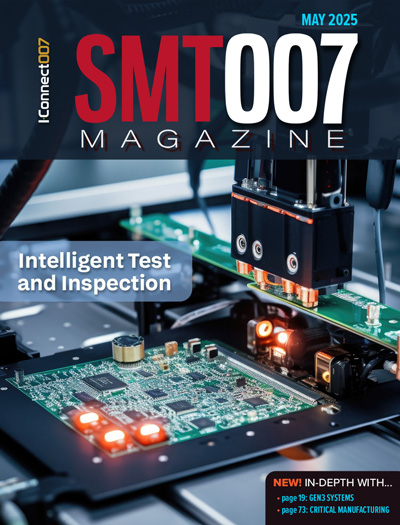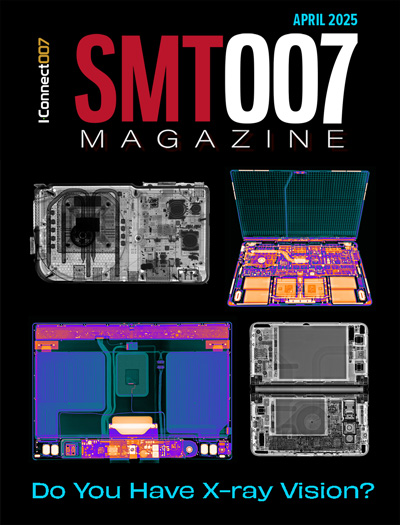-

- News
- Books
Featured Books
- smt007 Magazine
Latest Issues
Current Issue
Moving Forward With Confidence
In this issue, we focus on sales and quoting, workforce training, new IPC leadership in the U.S. and Canada, the effects of tariffs, CFX standards, and much more—all designed to provide perspective as you move through the cloud bank of today's shifting economic market.

Intelligent Test and Inspection
Are you ready to explore the cutting-edge advancements shaping the electronics manufacturing industry? The May 2025 issue of SMT007 Magazine is packed with insights, innovations, and expert perspectives that you won’t want to miss.

Do You Have X-ray Vision?
Has X-ray’s time finally come in electronics manufacturing? Join us in this issue of SMT007 Magazine, where we answer this question and others to bring more efficiency to your bottom line.
- Articles
- Columns
Search Console
- Links
- Media kit
||| MENU - smt007 Magazine
How DFA Converts Complexity into Freedom for Medical Device Development
August 2, 2018 | Craig Stott, Ed Sermanoukian, and Girish Wable, NyproEstimated reading time: 4 minutes
The assembly of medical devices comprising electronic and mechanical components has always been one of many considerations in the product development cycle. But the assembly phase has become an increasing challenge as devices grow more complex, functional and compact, and as they undergo increasingly frequent product refresh cycles. The medical devices emerging today have evolved from purely mechanical systems into sophisticated electro-mechanical designs that are embedded in and driven by a rapidly growing connected digital health ecosystem. As a consequence, many now incorporate integrated sensing, power, processing, communication and analytics functions in ever-shrinking form-factors designed for optimal reliability, power efficiency and ease of use. Concurrent with this evolution, the various global reimbursement policies and regulatory approval processes for medical devices are also becoming more complex.
This growing complexity of medical devices is also unfolding in parallel with an increasingly competitive marketplace, which is putting pressure on device innovators to combine fundamental design for excellence rules, good manufacturing practices for supply chain and manufacturing operations, and innovative new materials and processes to deliver accretive value at rapid speeds and lowest cost.
Put simply, the design process is still driven by product requirements. By also considering the optimum path for assembly, however, manufacturers can achieve further benefits in the overall quality, reliability, time to market, cost and—most importantly—the efficacy of their medical device.
But what factors determine the best method of assembly? How, for example, do you choose between a manual, semi-automatic, fully automatic and flexible automation solution upfront when your device will go through rapid product refresh cycles?
One way to optimize both the design of a device and the efficiency of its assembly process is to employ design for X (DFX) review tools. Whether focused on manufacturability (DFM) or assembly (DFA), utilizing these design tools early in the product development process can anticipate and avoid many barriers to efficiency and performance, and achieve faster time to market.
A medical device designer, for example, may have a very clear vision of a product’s end requirements. But they may have overlooked common issues that arise during the intermediate assembly phase, where there are often potential trade-offs to consider, such as the comparatively higher assembly and testing costs for a medical device that must reliably deliver over a million hours of service.
A design for assembly (DFA) approach anticipates these questions and prioritizes assembly methods and costs accordingly within the overall product development cycle. A typical DFA process might consider, for example, the percentage of parts standardized across different assemblies, part count consolidation and modularity, minimization of handling and cycle times, standardization of gripping methods and opportunities to reduce post assembly processes. The DFA process also seeks to minimize the time it takes to operationalize product assembly, and to ensure that supplier maturity will remain consistent over the period of development. Another important input of the DFA process is support for other DFX guidelines as part of continuous improvement. Ultimately, DFA should help to reduce throughput time, control assembly costs, enhance safety for operators, and ensure a design meets all specification, quality and reliability targets at an acceptable product cost.
Options Need Not Overwhelm
Depending on product requirements and design, assembly can be as simple as mechanically snapping components together or as complex as using functional integration like adhesives, welding or riveting. Product managers also must often choose between manually assembling devices vs employing semi-automatic or fully automatic options during the early design development stage.
Further complicating the selection process are the number of different assembly methods, which include:
1. Deformation methods based on press fit, heat staking, swaging, molded-in snap latches and retention features designed into mating parts
2. Mechanical fastening methods, encompassing the use of screws, bolts, rivets, pins, retention rings, springs or clips
3. Welding parts using ultrasonic, radio or high frequency, laser and spin tools
4. Soldering mechanical or electronics parts on a PCB
5. Bonding parts using pressure sensitive adhesives, epoxies, cyanoacrylates, polyurethanes or solvent cement materials. Bonding may also span employ processes, such a dispensing, curing, laminating, molding, coating and so on
6. Marking parts for component or assembly tracking, while not expressly involving assembly, may still eliminate, streamline or influence assembly processes. Marking encompasses surface treatments through flame, corona, plasma, solvent or ultrasonic washing, and may apply tools such as lasers, ink jet, bar coding, pin coding or adhesive labels
7. Testability or access to inline testing should be considered during design phase, testability should be considered to ensure that, at a certain assembly stage, the device has access points to test for pass/fail prior to proceeding to next station
The long list above still leaves open the question of whether the assembly method chosen should apply a manual or automated process. Manual assembly is best suited for high-complexity, low-volume assembly. Ideally, a complex assembly should be broken down into incremental assembly steps that can be handled by fixturing or automation to ensure manual assembly does not cause fatigue or errors.
Automated and semi-automated processes are better suited for assembly applications demanding consistent repeatability, conformance to strict time requirements, or production volumes over a million devices per year.
Flexible automation solutions based on a common standard platform where fixtures and tools can be reconfigured and adapted are favored for products that are customized for different markets or that go through frequent product refresh cycles. Additional automation benefits include reduced risk, scrap, errors and assembly time, as well as reduced operator hazard and fatigue. Automation also allows for data collection and analytics that help isolate issues more efficiently and resolved them more quickly to minimize downtown. The goal of DFA is to ensure the right decisions are made during the design phase to ensure higher quality, higher reliability, lower cost, and faster time to market.
To read the full version of this article, which appeared in the July 2018 issue of SMT007 Magazine, click here.
Suggested Items
Indium Elevates Two Leaders Advancing PCB Assembly Innovation
06/10/2025 | Indium CorporationWith its commitment to innovation and growth through employee development, Indium Corporation is pleased to announce the promotions of Wisdom Qu to Senior Product Manager for PCB Assembly Products and Kevin Brennan to Senior Product Development Specialist.
PMGC Holdings Signs Letter of Intent to Acquire Profitable U.S.-Based Electronics Manufacturing Company
06/10/2025 | Globe NewswirePMGC Holdings Inc., a diversified public holding company, is pleased to announce the signing of a non-binding Letter of Intent (LOI) to acquire a U.S.-based, cash-flow positive electronics contract manufacturing company with over 40 years of operational history.
Top Investment Certification on 2nd Anniversary Boosts ESCATEC’s European Presence
06/09/2025 | ESCATECTwo significant milestones in recent days by ESCATEC’s business unit in Bulgaria adds much momentum to the EMS provider’s strategy to nearshore cost-effective and high-quality electronics assembly and plastic moulding services for its customers in the European Union.
Breaking Silos with Intelligence: Connectivity of Component-level Data Across the SMT Line
06/09/2025 | Dr. Eyal Weiss, CybordAs the complexity and demands of electronics manufacturing continue to rise, the smart factory is no longer a distant vision; it has become a necessity. While machine connectivity and line-level data integration have gained traction in recent years, one of the most overlooked opportunities lies in the component itself. Specifically, in the data captured just milliseconds before a component is placed onto the PCB, which often goes unexamined and is permanently lost once reflow begins.
Catching Up With AMI EMS President Greg Boyd: Our People Make the Difference
06/04/2025 | Dan BeaulieuI’ve had the privilege to work with countless companies in the electronics manufacturing space, but few have impressed me as deeply as Alternative Manufacturing Inc. (AMI). Based in Winthrop, Maine, AMI is a 100% employee-owned company that embodies the very best of what American manufacturing can be. AMI sets itself apart by its unwavering commitment to quality, transparency, and partnership.


